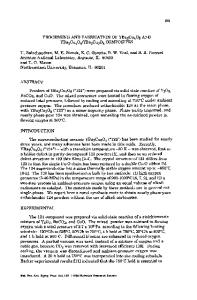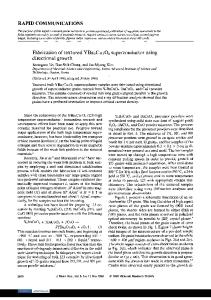Lanthanum doping of YBa 2 Cu 3 O x
- PDF / 390,859 Bytes
- 4 Pages / 593.28 x 841.68 pts Page_size
- 78 Downloads / 346 Views
The BOC Group, Inc., Technical Center, Murray Hill, New Jersey 07974 (Received 22 November 1989; accepted 15 February 1990) A wide variety of cation substitutions have been tried in the 1-2-3 compound, YBa2Cu3Ox, in the hope that its superconducting properties can be improved. While significant improvement has not been achieved, the response of the material to such substitutions can still be helpful in understanding its defect chemistry. In this paper, we report on measurements of the equilibrium oxygen content, by thermogravimetry, and the electrical conductivity of YBa2-zLazCu3O^, with 2 = 0, 0.1, and 0.2. The results are consistent with the view that the stoichiometric composition for this system, YBa2Cu3O6, is a highly acceptor-doped material.
I. INTRODUCTION
The oxygen content of YBa2Cu3Ox can vary continuously over the range 6 < x < 1 as a function of the temperature and oxygen activity, P(O2), at which it has been equilibrated. Over this range of compositions, the average formal oxidation state of the copper varies from 1.67 to 2.33, with values over 1.67 actually corresponding to a mobile hole concentration. The superconducting behavior is critically dependent on the oxygen content, with the optimum properties occurring near x = 7. It might be expected that aliovalent impurity substitutions could affect the oxygen content and the hole concentration significantly, with corresponding effects on the superconducting properties. A number of studies have been reported on lanthanum additions, usually in substitution for barium, with sometimes contradictory results.1"4 Lanthanum can be substitutionally incorporated into the barium sublattice by more than 10%.2 Substitution of a divalent barium ion by a trivalent lanthanum ion results in a positively charged impurity center, La^a- Such a center requires compensation by a negatively charged species to maintain electrical neutrality. Likely choices in this case are a reduction in the concentration of oxygen vacancies or a decreased average valence of copper. It has been previously shown that the transition from oxygen excess, /?-type conduction to oxygen deficient, «-type conduction in YBa2Cu3O;t occurs very close to the composition x = 6 under equilibrium conditions.5 This establishes YBa2Cu3O6 as the stoichiometric composition, i.e., the composition at which the electron and hole concentrations are equal, and results only from ionization across the band gap. When the material takes up a stoichiometric excess of oxygen at higher oxygen activity, the entering oxygen atoms pick up electrons from the valence band to become ions and J. Mater. Res., Vol. 5, No. 6, Jun 1990
http://journals.cambridge.org
Downloaded: 18 Mar 2015
create holes. On the oxygen deficient side of stoichiometry, the departing oxygens leave behind electrons. The equilibrium electrical conductivity is an indirect measure of the charge carrier concentrations. The conductivity will have its minimum value at the stoichiometric composition, neglecting any differences in the mobilities of electrons a
Data Loading...











